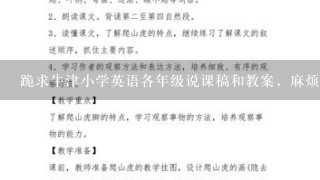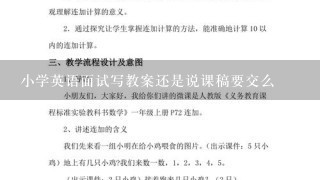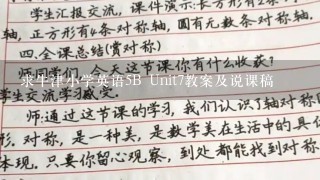小学EEC英语的教案,说课稿,课件那里能下到呀,跪求牛津小学英语各年级说课稿和教案,麻烦发到我的邮箱942551287@qq.com,万分感谢!

1、小学EEC英语的教案,说课稿,课件那里能下到呀
这跟你是哪里的没有关系,去你这本教材的出版社主页,里面有。或者百度,直接搜就有啊。

2、跪求牛津小学英语各年级说课稿和教案,麻烦发到我的邮箱942551287@qq.com,万分感谢!
网上很多说课,你想要哪1个去百度搜哪1课的,然后自己在这些里面截取比较好的,组合成1篇,这就是1篇好的说课稿。

3、小学3年级英语说课稿和教案
读书 抄词。

4、小学英语面试写教案还是说课稿要交么
面试主要看的是你的实际的讲课,有的学校在讲课之前是要说课的,说课大概就5分钟。教案的话有的学校是要看教案的,有的学校不要,你到时候可以问问,主要教案还是要体现出你的思路。其实准备时间有限,教案的话自己把握时间, 给自己要留1定的时间在心里默默顺1下过程,这样比较好,自己多练。练多了就顺手了,知道如何随机应变,也不会卡住啊啥的。 希望帮助到你,望采纳。

5、谁有小学英语教案和说课稿的模板,要全英文的??
我帮你找找。

6、求牛津小学英语5B Unit7教案及说课稿
Good afternoon, everyone. I’m Hu Huiyue. It’s my great pleasure to be here sharing my lesson with you. The content of my lesson is “A busy day” part A from Unit 7,Fun with English 5B. 1.Teaching contents The topics on Fun with English are well organized focusing on the pupils’ world. Unit 7 is intended for pupils to talk about their daily lives. They have learnt many verb phrases. Such as watch TV, have breakfast, clean the library, watch a football game, do homework and etc. You know they are bilingual class pupils, so maybe these phrases will be more easier for them. “A busy day” mainly talks about the time and what they should do at the time. Considering the contents of the lesson and the levels of the pupils, I design the following teaching aims.
2、Teaching aims1. Aims on the knowledge: Pupils will learn the new words “busy, past, to, on duty, brush teeth, really, half, a quarter ”, the new structures “ What time is it? It’s time for… Do you want to…? I want to… 2. Aims on the abilities: To develop pupils’ abilities of listening ,speaking, reading and writing. To develop pupils’ communicative skills3. Aims on the emotion: To develop pupils’ sense of co-operation. To let pupils know they should cherish the time.
3、Important points:1. To help the pupils say the new words and use the key sentences correctly. 2. To write whole sentences correctly.
4、Difficult points1. How to make dialogues and act them out. 2. Pupils can talk about the time and what they should do at the time.
5、Teaching aidsAnd in this lesson we’ll need CAI , Tape recorder, school things and so on.
6、Teaching methods Now I’d like to talk about my way of teaching(不必写在教案里).1. Communication methodI’ll set up a real situation, in this way , pupils can practise in pairs or in groups, they can speak freely and needn’t worry about making mistakes2. Task-based method That is to say I’ll let the pupils finish a task by making a short dialogue and acting it out. To help the pupils get a better understanding of the key structures, I will arrange these kinds of activities: singing, guessing game, finishing a survey and having a competition.
7、Learning methods Let pupils study in a relaxed and agreeable atmosphere. Thereby, develop the pupils’ abilities of studying and working with the learning language independently.
8、Teaching procedures Now I’ll mainly talk about my Teaching procedures. I’ll follow five steps.Step 1( Warm-up and revision) It is important to set up a better English learning situation for the pupils . So I ‘ll design Activity 1. Sing a song: Do some exercise with me? This song is from Unit6Activity2. TPR( Total Physical Response ) to ask pupils to follow my instructions, “get up, have breakfast, watch TV, do homework” then ask and answer: What are you doing? I am…T: Look, what am I doing?Present the new phrases: brush my teethT: Who is on duty today?Let the child give the orders which are on the paper.I design this activity to get pupils to warm up and review the present continuous tense. I also infiltrate two phrases in this step, “brush my teeth, on duty”. Because they will be presented in the text. Step 2 (Presentation ) To present and practice the key structures one by one, that’ll be much easier for the pupils to learn and grasp the meanings. So in this step, I’ll design 3 activities. Activity1: Guess and learn. Guess a riddle, then learn to express time in English. In this step, I will use CAI to help me with my teaching. Let children practice the time first. Then learn to use “past” and “to”Activity 2: Ask and answer. What time is it? It’s time for…Let pupils talk about the time : What time is it? It’s time to… Because pupils have already learned this structure .Then teacher can make a model first : It’s time for… Then practice in groups. As we all know, using the pictures, this is one of the easiest ways to show the meaning of the words and sentences. Activity 3: Talk and matchTalk about the time and the things first, then listen and match . If time is enough, pupils can talk about their own time and their own things.Children’s attention span is very short. And proper exercises can help pupils focus on their attention and practice the key structures better. Activity4: Think and sayT: Oh, what time is it now? It’s time to watch VCD. Do you want to watch VCD?S: I want to watch VCD.Teacher shows them a list, look at the time and things: What do you want to do? Then invite your friend: It’s … It’s time for… I want to … Do you want to…?In this activity, pupils are encouraged to put themselves in the situation and make a face to face talking. All the pupils are involved in this activity. They can talk as much as possible. Step3. (Production)To help pupils put the language into using, I design a task to help pupils have a production.First watch VCD. Let the Ss listen and imitate the dialogue. Pay attention to their pronunciation and intonation. At last I’ll ask the pupils to think hard and act it out. Then find out which group will act it out well. I’ll give them red stars. Purpose of my designing: This step makes the pupils get the general idea of the dialogue as a whole one. At the same time let the pupils have a chance to practise their listening and spoken ability. Step 4. (Consolidation) To develop pupils’ abilities of listening and speaking, that’s the main instructional aims of learning English in primary school. So in step 4, I’ll design some listening exercises to check what they have learned. For example: Think and fill in the blanks. Everyone will have a piece of paper. In this step I’ll give the pupils a free space to show their abilities. Purpose of my designing: “Task-based” teaching method is used here to develop the pupils’ ability of communication and co-operation. Tell the pupils we should cherish our time, Time and tide wait for no man. Step 5. (Homework )After step 4, some pupils can grasp the knowledge well, but some pupils can’t. Revision is so important, pupils should speak English after class as much as they do in class. It is necessary for the pupils to do some exercise after class. So I design the following homework.1. Listen and read.2. Try to talk about the pictures. 3. Try to finish your timetable My timetable TimeTimeWhat for?6:30Half past sixIt’s time for breakfast. :
9、.Blackboard Design Unit7 A busy dayWhat time is it? busy 繁忙It’s … past… on duty 值日It’s … to … brush teeth 刷牙It’s time for… Do you want to…? I want to…? Proverb: Time and tide wait for no man. 时间不等人。 In a word, the teaching of this lesson aims to develop not only the pupils' language abilities, but also the diverse intelligence. As eachers, to make our English classrooms shine with vitality, we still have a long way to go.Above is the lecture notes of my lesson. Thank you!





































































